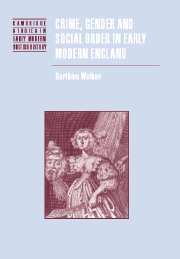Book contents
- Frontmatter
- Contents
- List of figures and tables
- Preface
- Note on quotations and dates
- List of abbreviations
- 1 Introduction
- 2 Men's non-lethal violence
- 3 Voices of feminine violence
- 4 Homicide, gender and justice
- 5 Theft and related offences
- 6 Authority, agency and law
- 7 Conclusion
- Bibliography
- Index
- Titles in the series
7 - Conclusion
Published online by Cambridge University Press: 14 July 2009
- Frontmatter
- Contents
- List of figures and tables
- Preface
- Note on quotations and dates
- List of abbreviations
- 1 Introduction
- 2 Men's non-lethal violence
- 3 Voices of feminine violence
- 4 Homicide, gender and justice
- 5 Theft and related offences
- 6 Authority, agency and law
- 7 Conclusion
- Bibliography
- Index
- Titles in the series
Summary
In the previous chapters, I have attempted to illuminate ways in which practices and discourses were interrelated, each informing the other. Hence, ideas are as important to understanding prosecutions, verdicts and sentences as are behaviours deduced from statistics. In the process, I have offered a critique of studies of crime in which female criminality is considered to be a mere shadow of ‘real’ male criminality. I have demonstrated that it is not useful to approach female criminality by focusing on the lenience with which women were treated relative to men. Indeed, the idea that women were treated leniently within the criminal justice process has been found wanting.
In chapters two and three, we saw that the formal record and terminology of violence does not take us far in assessing what was peculiarly masculine (or feminine) about violent acts. Indeed, there seems to have been little difference in the actual methods of fighting by men and by women. However, conceptions of the gravity of violence were always dependent upon context, on the relative positions within the social order of the parties concerned. Attending to the discourses with which early modern people expressed violent and disorderly behaviour illuminated the social meanings of violence and the different levels of ease with which male violence was articulated by men and by women. We discovered that a powerful discourse of the ‘man of honour’ provided a schema in which culpability for violence between men could be evaluated.
- Type
- Chapter
- Information
- Crime, Gender and Social Order in Early Modern England , pp. 270 - 279Publisher: Cambridge University PressPrint publication year: 2003



